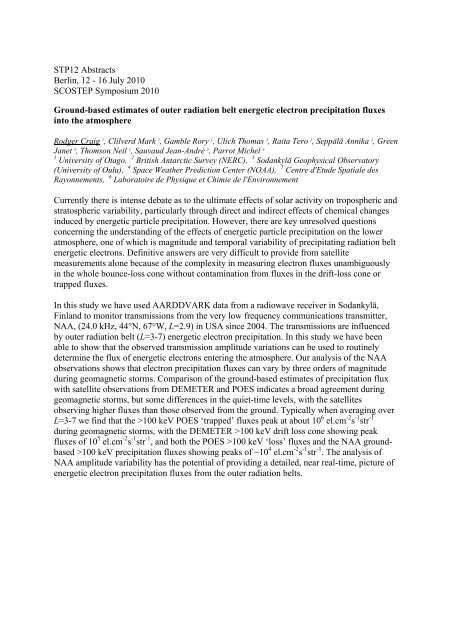scostep 2010 (stp12) - Leibniz-Institut für Atmosphärenphysik an der ...
scostep 2010 (stp12) - Leibniz-Institut für Atmosphärenphysik an der ...
scostep 2010 (stp12) - Leibniz-Institut für Atmosphärenphysik an der ...
You also want an ePaper? Increase the reach of your titles
YUMPU automatically turns print PDFs into web optimized ePapers that Google loves.
STP12 Abstracts<br />
Berlin, 12 - 16 July <strong>2010</strong><br />
SCOSTEP Symposium <strong>2010</strong><br />
Ground-based estimates of outer radiation belt energetic electron precipitation fluxes<br />
into the atmosphere<br />
Rodger Craig 1 , Clilverd Mark 2 , Gamble Rory 1 , Ulich Thomas 3 , Raita Tero 3 , Seppälä Annika 2 , Green<br />
J<strong>an</strong>et 4 , Thomson Neil 1 , Sauvaud Je<strong>an</strong>-André 5 , Parrot Michel 6<br />
1 University of Otago, 2 British Antarctic Survey (NERC), 3 Sod<strong>an</strong>kylä Geophysical Observatory<br />
(University of Oulu), 4 Space Weather Prediction Center (NOAA), 5 Centre d'Etude Spatiale des<br />
Rayonnements, 6 Laboratoire de Physique et Chimie de l'Environnement<br />
Currently there is intense debate as to the ultimate effects of solar activity on tropospheric <strong>an</strong>d<br />
stratospheric variability, particularly through direct <strong>an</strong>d indirect effects of chemical ch<strong>an</strong>ges<br />
induced by energetic particle precipitation. However, there are key unresolved questions<br />
concerning the un<strong>der</strong>st<strong>an</strong>ding of the effects of energetic particle precipitation on the lower<br />
atmosphere, one of which is magnitude <strong>an</strong>d temporal variability of precipitating radiation belt<br />
energetic electrons. Definitive <strong>an</strong>swers are very difficult to provide from satellite<br />
measurements alone because of the complexity in measuring electron fluxes unambiguously<br />
in the whole bounce-loss cone without contamination from fluxes in the drift-loss cone or<br />
trapped fluxes.<br />
In this study we have used AARDDVARK data from a radiowave receiver in Sod<strong>an</strong>kylä,<br />
Finl<strong>an</strong>d to monitor tr<strong>an</strong>smissions from the very low frequency communications tr<strong>an</strong>smitter,<br />
NAA, (24.0 kHz, 44°N, 67°W, L=2.9) in USA since 2004. The tr<strong>an</strong>smissions are influenced<br />
by outer radiation belt (L=3-7) energetic electron precipitation. In this study we have been<br />
able to show that the observed tr<strong>an</strong>smission amplitude variations c<strong>an</strong> be used to routinely<br />
determine the flux of energetic electrons entering the atmosphere. Our <strong>an</strong>alysis of the NAA<br />
observations shows that electron precipitation fluxes c<strong>an</strong> vary by three or<strong>der</strong>s of magnitude<br />
during geomagnetic storms. Comparison of the ground-based estimates of precipitation flux<br />
with satellite observations from DEMETER <strong>an</strong>d POES indicates a broad agreement during<br />
geomagnetic storms, but some differences in the quiet-time levels, with the satellites<br />
observing higher fluxes th<strong>an</strong> those observed from the ground. Typically when averaging over<br />
L=3-7 we find that the >100 keV POES ‘trapped’ fluxes peak at about 10 6 el.cm -2 s -1 str -1<br />
during geomagnetic storms, with the DEMETER >100 keV drift loss cone showing peak<br />
fluxes of 10 5 el.cm -2 s -1 str -1 , <strong>an</strong>d both the POES >100 keV ‘loss’ fluxes <strong>an</strong>d the NAA groundbased<br />
>100 keV precipitation fluxes showing peaks of ~10 4 el.cm -2 s -1 str -1 . The <strong>an</strong>alysis of<br />
NAA amplitude variability has the potential of providing a detailed, near real-time, picture of<br />
energetic electron precipitation fluxes from the outer radiation belts.











